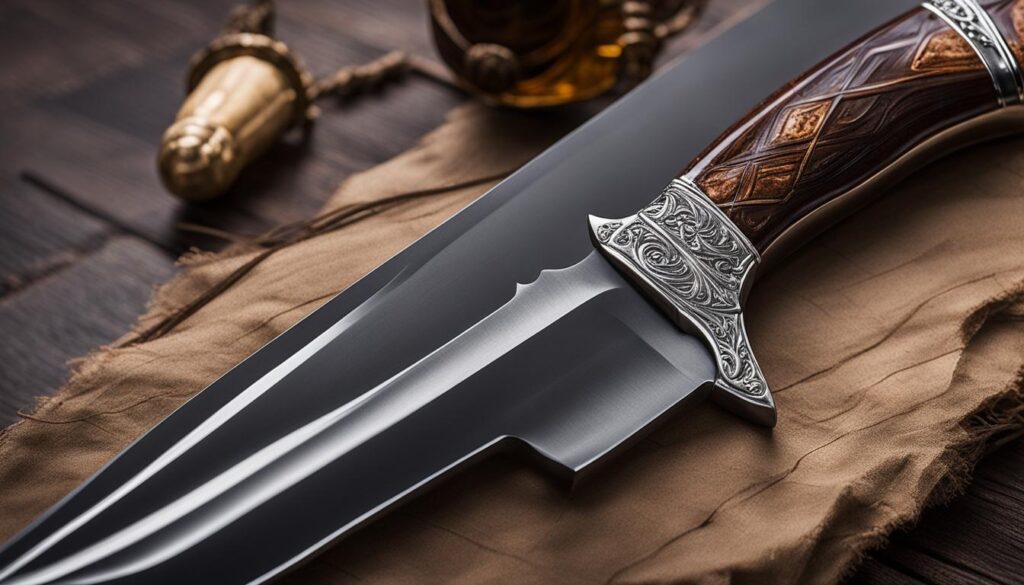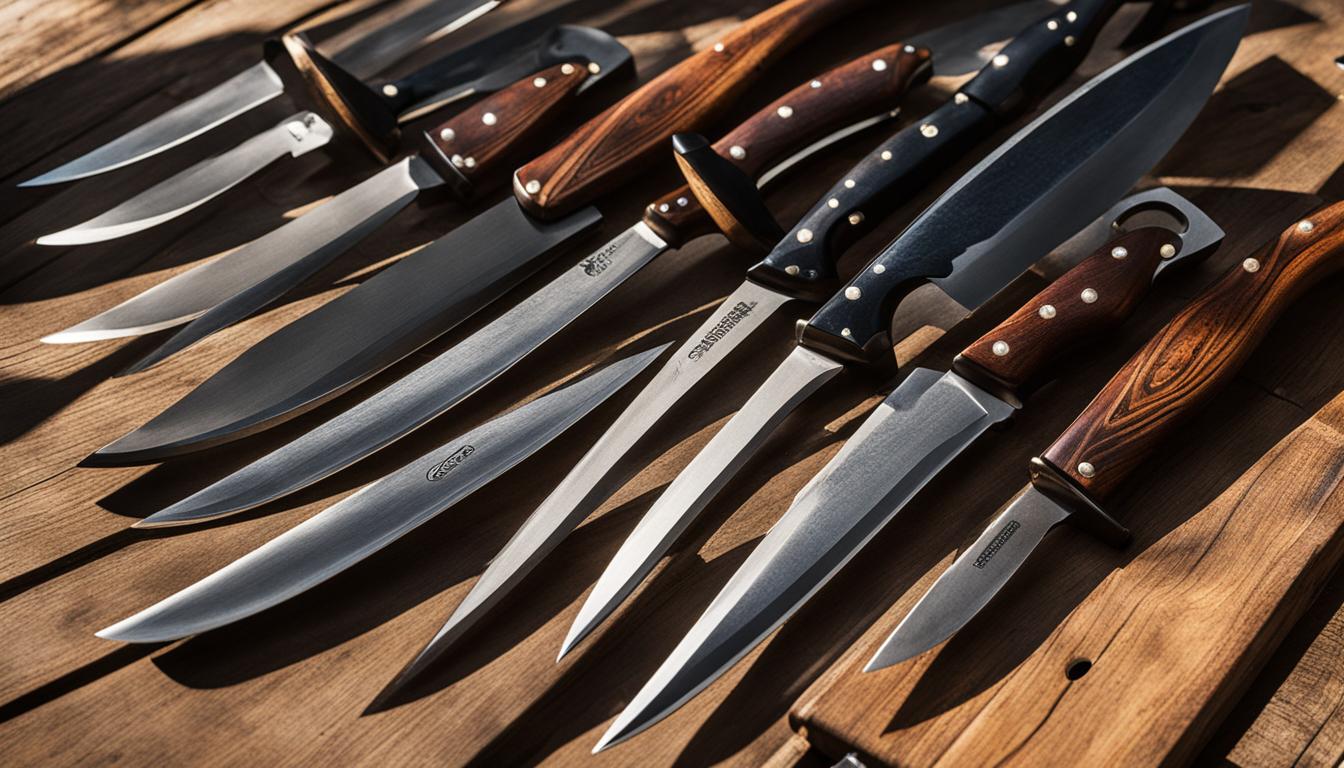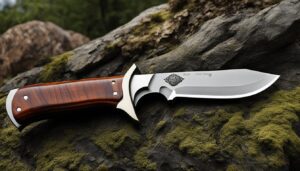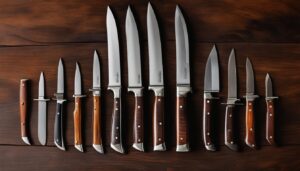When it comes to hunting, having the right tools is essential. And one tool that every hunter should have in their arsenal is a Bowie knife. A Bowie knife is a versatile and reliable blade that can be used for various tasks in the great outdoors. But with so many options available, how do you choose the perfect Bowie knife for your hunting needs? In this guide, I will walk you through the important factors to consider when selecting a Bowie knife, so you can make an informed decision and find the best blade for your hunting adventures.
Key Takeaways:
- Consider the intended use of the knife: survival, combat, hunting, or self-defense.
- Pay attention to blade size, design, and edge for optimal performance.
- Choose a durable tang construction and high-quality handle material for comfort and grip.
- Blade construction material affects sharpness, durability, and corrosion resistance.
- Investing in a high-quality Bowie knife ensures a reliable and durable tool for hunting.
A Brief History of Bowie Knife
The Bowie knife has a fascinating history that dates back to the 19th century. This iconic knife is named after James Bowie, a legendary figure known for his role in the SandBar fight. While the original design of the Bowie knife used by James Bowie himself is lost, it is believed to have been a large, single-edged knife with a blade over 9 inches in length and a wooden grip.
Rezin Bowie, James Bowie’s brother, is credited with commissioning a blacksmith named James Black to create this distinctive knife. It is said that Rezin Bowie gave the knife to his brother before the infamous sandbar fight. Since then, the Bowie knife has become synonymous with ruggedness and versatility, finding its place primarily as a tool rather than a weapon.
“The Bowie knife is a symbol of the American frontier and has been embraced by outdoorsmen and knife enthusiasts for generations.”
One of the defining characteristics of the Bowie knife is its unique blade design. The blade typically features a clipped point, which enhances the knife’s piercing capabilities while maintaining strength. The shape of the blade, combined with its length and sharpness, makes the Bowie knife an excellent tool for various outdoor activities, including hunting and camping.
Over the years, the Bowie knife has evolved, with different variations and adaptations to suit specific needs. While it has a rich history rooted in combat, the Bowie knife’s legacy as a reliable and versatile tool continues to thrive in today’s outdoor and survival communities.
An Example Table: Bowie Knife Styles
| Style | Description |
|---|---|
| Traditional Bowie | Characterized by a large, clip-point blade and a curved edge. Often features a crossguard to protect the hand. |
| Tactical Bowie | A modern interpretation of the Bowie knife, designed for combat and self-defense. Features a more streamlined profile and often incorporates advanced materials and additional features. |
| Hunting Bowie | A Bowie knife specifically designed for hunting purposes. Generally features a medium-sized blade with a drop point or a modified clip-point blade for enhanced precision and versatility. |
| Bushcraft Bowie | Combines the attributes of a Bowie knife with those of a bushcraft knife. Designed for outdoor enthusiasts who require a versatile tool for survival, bushcraft, and general outdoor tasks. |
Buying Guide for Bowie Knives
When it comes to purchasing a Bowie knife, there are several important factors to consider. These factors will help you find the perfect knife that meets your needs and preferences. One of the first things to consider is the size of the blade. Most outdoor enthusiasts prefer a blade that measures between 7 to 9 inches in length. This size offers a good balance between versatility and maneuverability.
The design of the blade is another crucial consideration. There are different types of blade designs, such as clip point, drop point, and straight back. Each design has its own unique advantages and uses. The clip point, for example, is ideal for piercing and detail work, while the drop point offers excellent control and versatility for hunting and survival tasks. The straight back design provides strength and durability for heavy-duty cutting tasks.
The design of the blade’s edge is equally important. Different edge designs, such as straight edges or recurved edges, offer different cutting capabilities. A straight edge is easy to maintain and provides a clean, precise cut, while a recurved edge provides additional slicing power for tasks like skinning game.
| Blade Material | Handle Material | Construction Procedure |
|---|---|---|
| Stainless Steel | Wood | Full Tang |
| Damascus Steel | Bone | Hidden Tang |
| Synthetic Materials | Partial Tang |
Blade material, handle material, and construction procedure should also be taken into consideration. High-quality blade materials like stainless steel and Damascus steel offer excellent durability and sharpness retention. The handle material should provide a comfortable and secure grip, with options like wood, bone, or synthetic materials. The construction procedure, whether it’s full tang, hidden tang, or partial tang, affects the knife’s overall strength and stability.
By considering these factors, you can confidently choose a Bowie knife that suits your needs and preferences. Whether you’re an avid hunter, outdoor enthusiast, or someone who values a reliable and versatile tool, a well-chosen Bowie knife will serve you well in a variety of situations.

The Importance of Quality Blades and Materials
When it comes to Bowie knives, the quality of the blades and materials used is of utmost importance. Investing in a high-quality Bowie knife not only ensures superior performance but also guarantees long-lasting durability.
One of the key factors to consider is the blade material. Stainless steel and Damascus steel are popular choices known for their sharpness, durability, and resistance to corrosion. These materials ensure that your Bowie knife retains its cutting edge even after extended use in various outdoor activities.
Opting for superior blade materials, such as stainless steel or Damascus steel, ensures sharpness, durability, and resistance to corrosion.
Equally important is the handle material. The handle provides the necessary grip and comfort during use. Options like wood, bone, or synthetic materials offer different levels of durability and aesthetics. Choosing the right handle material is essential to ensure a secure grip and minimize the risk of accidents.
By selecting Bowie knives made with high-quality blades and materials, you can enjoy a reliable tool that performs exceptionally well in hunting and other outdoor activities. These knives withstand the elements and challenges of the wilderness, providing you with the confidence and reliability you need in the field.


Table: Blade and Handle Material Comparison
| Blade Material | Handle Material |
|---|---|
| Stainless Steel | Synthetic Materials |
| Damascus Steel | Wood |
| Bone |
The table above provides a comparison of different blade and handle materials commonly used in Bowie knives. Synthetic materials, such as reinforced polymers, offer high durability and resistance to impact. Wood handles provide a traditional and aesthetic appeal, while bone handles add a touch of uniqueness. Consider your personal preferences and the intended use of the knife when choosing the most suitable combination of blade and handle materials.
In conclusion, the quality of the blades and materials used in Bowie knives significantly impacts their performance and longevity. By opting for superior blade materials and selecting the right handle material, you can ensure that your Bowie knife withstands the test of time and serves you well in all your outdoor adventures.
What to Consider When Choosing a Bowie Knife
When selecting a Bowie knife, there are several factors to consider. The first consideration is the blade size and shape. For outdoor activities like hunting and camping, longer blades are often preferred, as they provide better reach and cutting power. On the other hand, shorter blades are more suitable for everyday tasks where maneuverability and precision are important. Take into account your specific needs and preferences when determining the size and shape of the blade.
The blade material is another important factor to consider. Stainless steel and Damascus steel are popular choices due to their durability, corrosion resistance, and ability to retain a sharp edge. Stainless steel is known for its affordability and ease of maintenance, while Damascus steel offers a distinctive pattern and exceptional strength. Consider the material that best suits your intended use and maintenance preferences.
Equally important is the handle material of the Bowie knife. The handle should provide comfort and a secure grip for optimal control and maneuverability. Wood handles offer a traditional and natural feel, while bone handles provide durability and a unique aesthetic. Synthetic materials, such as G-10 or Micarta, offer enhanced durability and grip strength. Consider the handle material that feels most comfortable in your hand and complements your personal style.
Key Considerations in Choosing a Bowie Knife:
- Blade size and shape
- Blade material
- Handle material
By carefully considering these factors, you can select a Bowie knife that meets your specific needs and preferences. Whether you’re an avid hunter, a camping enthusiast, or simply a collector of fine blades, choosing the right Bowie knife will ensure a reliable and versatile tool for all your outdoor adventures.
Conclusion
In conclusion, when it comes to choosing the best Bowie knife for hunting, there are several key factors to consider. By following a comprehensive buying guide and taking individual preferences into account, users can select a Bowie knife that perfectly suits their needs.
When selecting a Bowie knife, it is crucial to consider the blade size and shape. Longer blades are ideal for outdoor activities such as hunting and camping, while shorter blades are more suitable for everyday tasks.
Additionally, the choice of blade material is paramount. Opting for durable materials like stainless steel or Damascus steel ensures the knife remains sharp, resistant to corrosion, and able to retain its edge for a long time. Similarly, the handle material should provide comfort, grip, and durability, with options ranging from traditional wood and bone to modern synthetic materials.
Investing in a high-quality Bowie knife is essential for hunters and outdoor enthusiasts. Some of the best options available on the market include the Ka-Bar U.S. Marine Corps Bowie Knife, the Condor Undertaker Bowie Knife, and the Buck Knives 119 Special Knife. These knives are renowned for their exceptional performance, superior craftsmanship, and durability.
FAQ
What factors should I consider when choosing a Bowie knife for hunting?
When choosing a Bowie knife for hunting, consider factors such as the intended use of the knife, including survival, combat, hunting, or self-defense. Additionally, factors like the size of the blade, design of the blade and edge, construction of the tang, material of the handle, and blade construction material should be taken into account.
What is the history of the Bowie knife?
The Bowie knife has a rich history dating back to the 19th century. The original design used by James Bowie during the SandBar fight is lost, but it is believed to have been a large, single-edged knife with a blade over 9 inches in length and a wooden grip. Rezin Bowie commissioned blacksmith James Black to create this knife, and it is believed that he gave it to his brother before the infamous sandbar fight. Bowie knives have since been primarily used as tools rather than weapons, with a focus on durability, size, and versatility.
What should I consider when buying a Bowie knife?
When buying a Bowie knife, consider factors such as the size of the blade (typically 7 to 9 inches), the design of the blade (clip point, drop point, straight back), the design of the edge (straight or recurved), the blade material (stainless steel, Damascus steel), the tang construction (full tang, hidden tang, or partial tang), and the handle material (wood, bone, synthetic materials).
Why is the quality of the blade and materials important in Bowie knives?
The quality of the blade and materials used in Bowie knives play a vital role in their performance and longevity. Opting for superior blade materials, such as stainless steel or Damascus steel, ensures sharpness, durability, and resistance to corrosion. The handle material affects comfort, grip, and aesthetics. By choosing Bowie knives made with high-quality blades and materials, users can enjoy superior performance, extended durability, and reduced maintenance.
What should I consider when selecting a Bowie knife?
When selecting a Bowie knife, consider factors such as the size and shape of the blade (based on the intended use), the blade material (for durability, corrosion resistance, and edge retention), and the handle material (for comfort, grip, and durability). By considering these factors, users can choose a Bowie knife that suits their specific needs and preferences.





